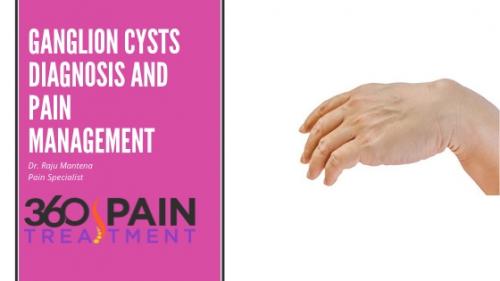Ganglion Cysts – Diagnosis and Pain Management

Ganglion Cysts (Bible cysts) are non-cancerous lumps in the hand. They usually appear along joints or tendons. The cysts occur on the hand or wrist but can also appear on the foot or ankle.
The cyst appears like a sac of liquid. A colorless, clear, thick and sticky liquid is found inside the sac. Depending on the size of the cyst they may feel spongy or firm.
Dr. Raju Mantena identifies the cause of the pain. This helps in determining the best treatment. The best treatment helps alleviate the pain and enable patients to regain their life. 360 Pain Treatment is a holistic approach to treating pain.
Symptoms
- Ganglion cysts often cause some degree of pain. If the cyst presses on a nerve, it can cause considerable pain, muscle weakness, numbness, and tingling. The pain is usually chronic. It is often made worse by joint motion.
- If the cyst is connected to a tendon, a sense of weakness is felt in the affected finger.
- The cysts are oval or round. They usually appear as a mass that changes size.
- The swelling appears over time. It gets bigger or smaller in size. The swelling may even go away and reappear later.
- The cysts develop along the joints or tendons of the hands and wrist. Feet and ankle are also common locations. The cysts can appear near other joints too.
Treatment
Non-Surgical Treatment
- Observation
Ganglion cysts are not cancerous. They most often disappear with time. If you don’t have any symptoms, the doctor may recommend waiting and watching. This is done to ensure that no unusual changes occur.
- Immobilization
An activity that increases pressure on the nerve causes pain. The activity causes the cyst to increase in size. A splint or wrist brace relieves symptoms. It also causes the ganglion cysts to decrease in size.
When the pain decreases, the doctor prescribes exercises. The exercises improve the range of motion and strengthen the wrist.
- Aspiration
If the ganglion cyst limits activities or causes considerable pain, fluid is drained from the cyst. The procedure is known as aspiration. The cyst is punctured with a needle after numbing the area around it. The fluid is then withdrawn.
The connection to the tendon sheath or the joint should be removed to prevent from cyst from occurring again. Aspiration procedure doesn’t remove the root of the cyst. In most cases, the cyst returns after the procedure.
Surgery
Surgery is recommended if the ganglion cyst returns after aspiration. The surgical procedure that is used to remove the cyst is known as excision. Excision is an outpatient procedure. Patients are able to go home after a period of observation.
360 Pain Treatment is a multidisciplinary approach to treating pain. The treatment helps achieve sustainable long-term relief without surgery. The treatment improves quality of life and enables patients to return to an active lifestyle.
Dr. Raju Mantena is an expert in pain management. A personalized treatment plan is developed to address the unique needs of each patient. The different treatment options enable patients to get back to their productive lifestyle.
Post Your Ad Here
Comments